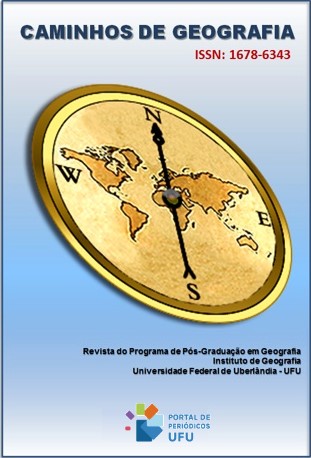CHARACTERIZATION OF RIVER TERRACES IN THE RIVER BASIN CANAPI – AL/PE, FROM THE ANALYSIS OF (DIS)CONNECTIVITY OF THE LANDSCAPE
DOI:
https://doi.org/10.14393/RCG249466147Keywords:
Rivers, Semiarid, River deposits, River disconnectionsAbstract
To understand the current landscape configuration it is essential to analyze the geomorphological features and processes that were responsible for its evolution. Thus, the integrated analysis of geomorphological and stratigraphic aspects constitute an important line of investigation of the evolutionary dynamics of the Quaternary, especially the old processes that were responsible for the dynamics of landscape evolution. The main objectives of this study were to delimit the river terraces of the Canapi watershed, correlate them with the pattern of (dis)connectivity and characterize the river channel seeking to understand the behavior of the main watercourse from the conception of river connectivity in a semiarid environment. From the integration of literature review, mapping of geomorphological units, land use and landscape disconnections, it was possible to characterize these river deposits, and thus contribute to studies on environmental and fluvial dynamics, with this, assisting in the proper occupation and management of natural resources. In general, it was found that the Canapi watershed has a large (dis)connectivity, especially in the main channel, contemplating the three spheres: longitudinal, vertical and lateral.
Downloads
Downloads
Published
How to Cite
Issue
Section
License
Copyright (c) 2023 Adelaine Firmino da Silva, Melchior Carlos do Nascimento, Flavia Jorge de Lima

This work is licensed under a Creative Commons Attribution-NonCommercial-NoDerivatives 4.0 International License.
Autores que publicam nesta revista concordam com os seguintes termos: a) Autores mantém os direitos autorais e concedem à revista o direito de primeira publicação, com o trabalho licenciado sob a Creative Commons Atribuição-NãoComercial-SemDerivações 4.0 Internacional. b) Autores têm permissão e são estimulados a publicar e distribuir seu trabalho online (ex.: em repositórios institucionais ou na sua página pessoal), já que isso pode gerar alterações produtivas, bem como aumentar o impacto e a citação do trabalho publicado. c) Em virtude de aparecerem nesta revista de acesso público, os artigos são de uso gratuito, com atribuições próprias, em aplicações educacionais e não-comerciais.











